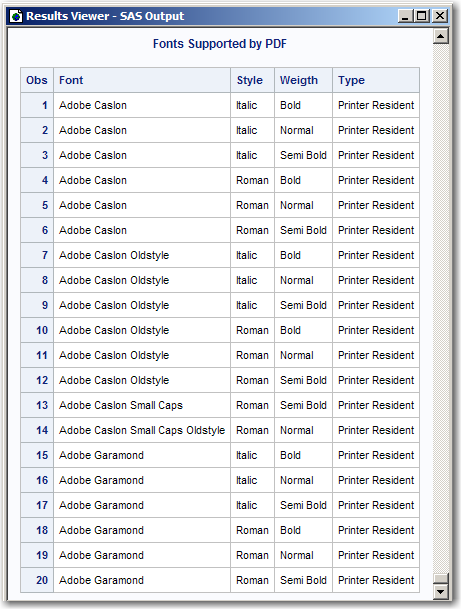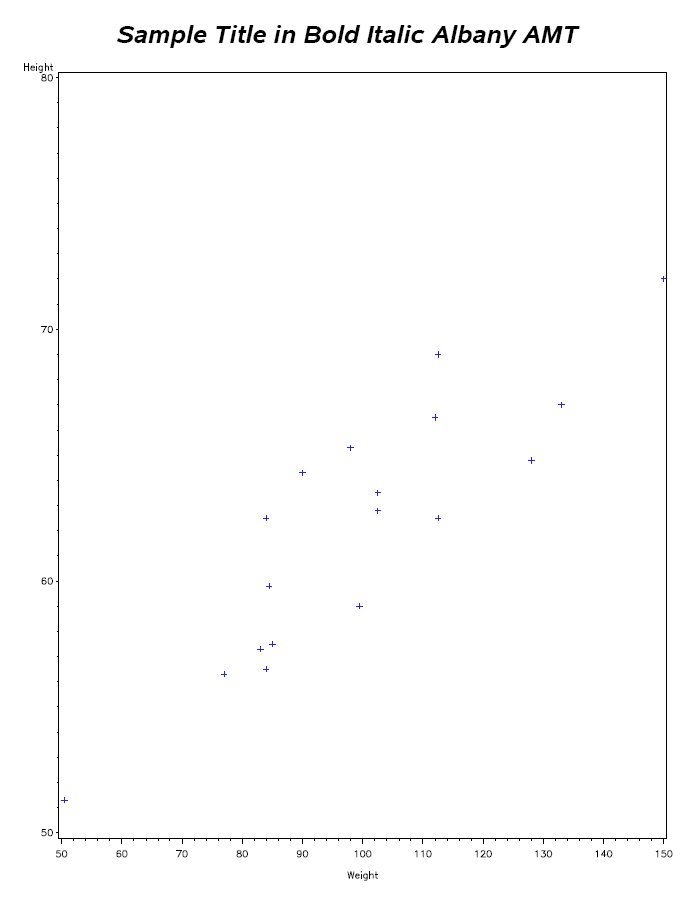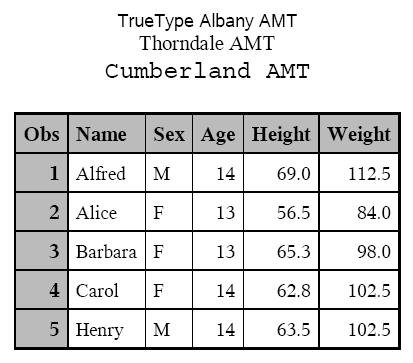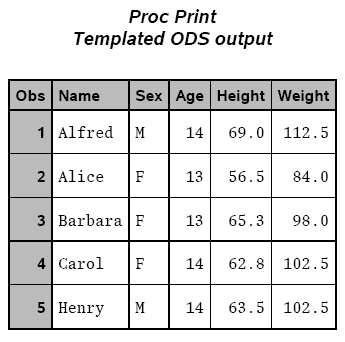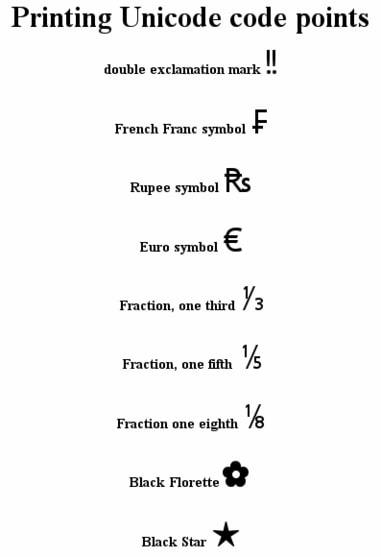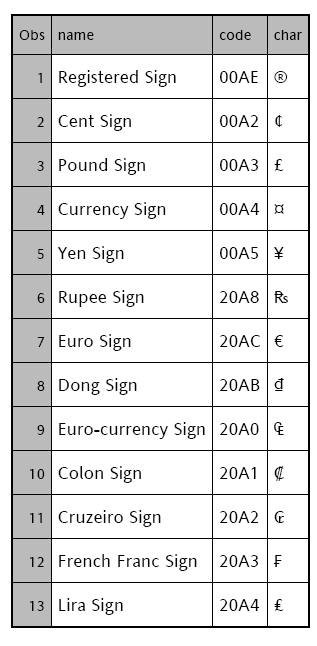Using Fonts with Universal Printers and SAS/GRAPH Devices
Rendering Fonts
In
SAS 9.3, TrueType and Type1 fonts are rendered by using the FreeType
library or by exercising the font-rendering capabilities of the host.
Output methods that
use the FreeType library are preferred because they can render fonts
in all of the operating environments that SAS supports. The following
Universal Printers and SAS/GRAPH devices are recommended because they
use the FreeType library.(footnote1) to
render fonts.
Devices That Use the FreeType Library to Render Fonts
|
SVG, SVGT, SVGVIEW,
and SVGZ1
|
|
|
SASEMF, SASWMF2
|
|
|
EMF universal printer2
|
|
|
PNG, UEMF, SASEMF 1
|
|
|
PNG, PNGT, PNG300, GIF,
JPEG, SASBMP, SVG, SVGT 1
|
|
| 1If the NOFONTRENDERING option is set, SVG uses the FreeType library only for measuring the text. The font rendering is done by the browser using system installed fonts. | |
| 2These devices use the FreeType library only for measuring text. The final font rendering is done by an application such as Microsoft Word, which displays the output using system installed fonts. | |
Font embedding allows
the fonts used in the creation of output to travel with that output,
ensuring that it is displayed or printed exactly as you intended.
For more information about the FONTEMBEDDING system option see FONTEMBEDDING System Option in SAS System Options: Reference.
Note: You can set
OPTIONS
FONTRENDERING= FREETYPE_POINTS | HOST_PIXELS to change
the rendering method for devices that support both FreeType library
and host rendering.
UNIX Specifics: With
devices that use host rendering in a UNIX operating environment, the
TrueType fonts must be installed in the X server that is being used.
This is usually specified by the DISPLAY environment variable. For
more information, see the Configuration Guide for SAS 9.3
Foundation for UNIX Environments.
ODS Styles and TrueType Fonts
By default, many SAS/GRAPH device drivers and all Universal
Printers generate output by using ODS styles, and these ODS styles
use TrueType fonts. If no style is specified, the default style is
used. If you want the appearance of graphs to be compatible with graphs
that were generated prior to SAS 9.2, set
the GSTYLE system option to specify NOGSTYLE. For information about
the GSTYLE System Option, see GSTYLE System Option in SAS System Options: Reference.
International Character Support
TrueType fonts support a wide
range of international characters. For more information
about SAS code that uses TrueType fonts, see Examples of Specifying Fonts and Printing International Characters.
TrueType Fonts Supplied by SAS
When you install SAS,
a number of TrueType fonts are available based on choices that were
made during the installation. TrueType fonts that are supplied by
SAS can be categorized into four groups: Windows Gylph List (WGL)
Pan-European character set fonts that are compatible with Microsoft;
graphic symbol; multilingual; and monolingual Asian. These fonts are
about the same shape and size as the Microsoft fonts and can be substituted
for the Microsoft fonts without changing formatting or paging. The
following table shows the SAS font and the compatible Microsoft font.
Windows Gylph List (WGL) Pan-European Character Set Fonts That
Are Compatible with Microsoft
|
serif fixed1
|
||
| 1Fixed refers to uniform spacing. | ||
Graphic Symbol TrueType Fonts
|
Monotype Sorts1
|
Not applicable1
|
Not applicable1
|
|
|
42 symbols2
|
|||
|
42 symbols2
|
|||
|
42 symbols2
|
|||
|
42 symbols2
|
|||
|
42 symbols2
|
|||
|
42 symbols2
|
|||
|
42 symbols2
|
|||
|
42 symbols2
|
|||
| 1SAS Monotype Sorts is an ornamental font consisting of shapes, symbols, and decorative glyphs that have no one-to-one mapping to Microsoft TrueType or Adobe Type1 fonts. However, the SAS Monotype Sorts font closely resembles Microsoft "Wingdings" TrueType and Adobe "ITC Zapf Dingbats" Type1 fonts. | |||
| 2These fonts have special glyphs for the Latin characters 0, <. =, C, D, L, M, N, P, R, S, U, V ,W, X, Z, and a–z. All other characters are undefined and might be rendered as a rectangle. For example, in the HTML destination, the rectangle is replaced with the matching Latin1 character when it is displayed in Internet Explorer. | |||
Multilingual TrueType Fonts
|
Monotype Sans WT 1
|
||
|
Thorndale Duospace WT
J1
|
||
|
Monotype Sans WT K1
|
||
|
Thorndale Duospace WT
K1
|
||
|
Monotype Sans WT SC1
|
||
|
Thorndale Duospace WT
SC1
|
||
|
Monotype Sans WT TC1
|
||
|
Thorndale Duospace WT
TC1
|
||
| 1Both Thorndale Duospace WT and Monotype Sans WT support HKSCS (Hong Kong Supplement Character Set) and substantially support the GB18030 standard. | ||
Monolingual Asian TrueType Fonts
|
Traditional Chinese1
|
||
| 1HeiT, MingLiU, MingLiU_HKSCS, and PMingLiu support HKSCS2004 (Hong Kong Supplemental Character Set) characters. | ||
The fonts that are supplied
by SAS and the fonts that are already installed on Windows are automatically
registered in the SAS registry when you install SAS. Fonts already
installed on UNIX and z/OS must be registered manually in the SAS
registry after you install SAS. To register other TrueType
Fonts, see Registering Fonts.
Registering Fonts
Fonts Supported by SAS
In addition to the TrueType
fonts that come installed with SAS, SAS supports PostScript Type1
fonts. The following table shows the font prefix and file extension
for TrueType and Type1 fonts:
Supported Font Types for SAS 9.3
|
.pfb 1
|
||
| 1Data
from a .pfm file is used to generate output using the |
||
Registering Fonts with the SAS Registry
To use TrueType or Type1 fonts that are not registered
when SAS is installed, use the FONTREG procedure to register these
fonts in the SAS registry. For more information, see FONTREG Procedure in Base SAS Procedures Guide.
Registering Fonts for UNIX, Windows, or the z/OS HFS File System
Submit the following SAS
program. The FONTPATH statement specifies the directory that contains
the fonts and
pathname is the directory
path of the fonts.proc fontreg;
fontpath 'pathname';
run;For more information
about adding fonts to the SAS Registry, see FONTREG Procedure in Base SAS Procedures Guide.
Note: In Microsoft Windows environments,
TrueType fonts are usually located in either the
C:\WINNT\Fonts or C:\Windows\Fonts directory.
For all other operating environments, contact your system administrator
for the location of the TrueType font files.
For more information,
see FONTREG Procedure in Base SAS Procedures Guide.
Registering Fonts for z/OS
On z/OS systems that do not use the HFS file system,
you can use the FONTFILE statement instead of the FONTPATH statement
to specify the fixed block sequential file that contains a font. Because
the default value of MODE= option is ALL, the PROC statement below
adds new fonts that do not already exist in the SAS registry and replaces
fonts that already exist in the SAS registry.
proc fontreg;
fontfile 'filename';
run;z/OS Specifics: When
you add fonts to a z/OS system, the font file must be allocated as
a sequential data set with a fixed block record format and a record
length of 1.
For more information,
see FONTREG Procedure in Base SAS Procedures Guide.
Listing the Registered Fonts for a Device
You can use the QDEVICE procedure
to view the list of fonts that have been registered in the SAS registry,
including fonts that you registered with the FONTREG procedure. You
can submit the following program to view fonts for a device or universal
printer.
/* Macro FONTLIST - Report fonts supported by a device */
%macro fontlist(type, name);
proc qdevice report=font out=fonts;
&type &name;
var font ftype fstyle fweight;
run;
data;
set fonts;
drop ftype;
length type $16;
if ftype = "System"
then do;
if substr(font,2,3) = "ttf" then type = "TrueType";
else if substr(font,2,3) = "at1" then type = "Adobe Type1";
else if substr(font,2,3) = "cff" then type = "Adobe CFF/Type2";
else if substr(font,2,3) = "pfr" then type = "Bitstream PFR";
else type = "System";
if type ^= "System" then font = substr(font,7,length(font)-6);
else if substr(font,1,1) = "@" then font = substr(font, 2,length(font)-1);
end;
else type = "Printer Resident";
run;
proc sort;
by font;
run;
title "Fonts Supported by the %upcase(&name) &type";
proc print label;
label fstyle="Style" fweight="Weigth" font="Font" type="Type";
run;
%mend fontlist;
%fontlist(printer, pdf)
%fontlist(device, pdf)
%fontlist(device, win)
%fontlist(printer, png)
%fontlist(device, pcl5c)For more information,
see QDEVICE Procedure in Base SAS Procedures Guide.
Using Fonts
Specifying Fonts with the Print Dialog Box
After you update the
SAS Registry, the newly registered fonts are available for use within
SAS. To access the fonts interactively when Universal Printing is
enabled, follow these steps:
-
TrueType fonts are indicated by the letters
ttfenclosed in angle brackets (< >), and Type1 fonts are indicated by the lettersat1enclosed in angle brackets (< >). For example, the TrueType fontAlbany AMTis listed as<ttf> Albany AMTTimesis listed as<at1> Times. The three-character tag enclosed in angle brackets makes the distinction between the different types of fonts with the same name, such as<ttf> SymbolSymbolfont that resides on a physical printer. Fonts that do not have a<ttf> tag<at1><ttf> Symbol.
Specifying Fonts with SAS Program Statements
You can specify a font
in the TITLE statement. For example, if you want to use the TrueType
font Albany AMT on a TITLE statement, include the following line of
code in your SAS program.
Title1 f="Albany AMT" "Text in Albany AMT";
You can also specify
attributes such as style or weight in the TITLE statement by using
the forward slash (/) as a delimiter.
Title1 f="Albany AMT/Italic/Bold" "Text in Bold Italic Albany AMT";
For ODS templates, the
attributes are specified after the text size parameter. See
Specifying a Font with PROC PRINT and a User-Defined ODS Template for a complete example.
Specifying a Font with the SYSPRINTFONT Option
The SYSPRINTFONT=
system option sets the default font that you want to use for printing
from windows such as the Program Editor, the Log, and Output windows.
For example, you could use the SYSPRINTFONT= system option to print
your output in the Albany AMT font by submitting the following OPTIONS
statement.
options sysprintfont=("Albany AMT");You can also use the
SYSPRINTFONT= system option to specify the weight and size of a font.
For example, the following code specifies an Arial font that uses
bold face, is italicized, and has a size of 14 points.
options sysprintfont=("Arial" bold italic 14);For more information,
see the SYSPRINTFONT= System Option in SAS System Options: Reference.
Examples of Specifying Fonts and Printing International Characters
Specifying a Font with SAS/GRAPH
The following example creates
an output file,
sasprt.pdf, with a
title in the Albany AMT font that uses bold face and is italicized.options printerpath=pdf device=sasprtc; ods printer; title1 color=black f="Albany AMT/Italic/Bold" "Sample Title in Bold Italic Albany AMT"; proc gplot data=sashelp.class; plot height*weight; run; quit; ods printer close;
Specifying a Font with PROC PRINT
The following example
produces an output file ,
print1.pdf,
with the titles in the Albany AMT, Thorndale AMT, and Cumberland AMT
fonts.
Specifying a Font with PROC PRINT and a User-Defined ODS Template
The following example creates
a template of font styles and then produces a PDF file.
filename out 'print2.pdf';
options printerpath=(pdf out) device=sasprtc;
proc template;
define style New_style / store = SASUSER.TEMPLAT;
parent = styles.printer;
replace fonts /
'docFont' = ("Thorndale Duospace WT J", 12pt)
'headingFont' = ("Albany AMT", 10pt, bold)
'headingEmphasisFont' = ("Albany AMT", 10pt, bold italic)
'TitleFont' = ("Albany AMT", 12pt, italic bold)
'TitleFont2' = ("Albany AMT", 11pt, italic bold)
'FixedFont' = ("Cumberland AMT", 11pt)
'BatchFixedFont' = ("Cumberland AMT", 6pt)
'FixedHeadingFont' = ("Cumberland AMT", 9pt, bold)
'FixedStrongFont' = ("Cumberland AMT", 9pt, bold)
'FixedEmphasisFont' = ("Cumberland AMT", 9pt, italic)
'EmphasisFont' = ("Albany AMT", 10pt, italic)
'StrongFont' = ("Albany AMT", 10pt, bold);
end;
run;
ods printer style=New_style;
proc print data=sashelp.class;
title1 'Proc Print';
title2 'Templated ODS output';
run;
ods printer close;Printing International Characters
The following example
produces an output file,
titles.png.
It is printed ten Unicode characters.filename new 'titles.png'; options printerpath=(png new)device=sasprtc; ods printer; proc gslide; title1 "Printing Unicode code points"; title2 "double exclamation mark" f="Monotype Sans WT SC/Unicode" h=2 '203C'x; title3 "French Franc symbol " f="Monotype Sans WT SC/Unicode" h=3 '20A3'x; title4 "Lira symbol " f="Monotype Sans WT SC/Unicode" h=3 '20A4'x; title4 "Rupee symbol " f="Monotype Sans WT SC/Unicode" h=3 '20A8'x; title5 "Euro symbol " f="Monotype Sans WT SC/Unicode" h=3 '20Ac'x; title6 "Fraction, one third " f="Monotype Sans WT SC/Unicode" h=3 '2153'x; title7 "Fraction, one fifth " f="Monotype Sans WT SC/Unicode" h=3 '2155'x; title8 "Fraction one eighth " f="Monotype Sans WT SC/Unicode" h=3 '215B'x; title9 "Black Florette " f="Monotype Sans WT SC/Unicode" h=3 '273F'x; title10 "Black Star " f="Monotype Sans WT SC/Unicode" h=3 '2605'x; run; quit; ods printer close;
The following example
produces an output file,
utf8.gif.
It must be run with a UTF-8 server and requires a TrueType font that
contains the characters that are used. The table of character names
and the associated codes can be found on the Unicode Web site at http://www.unicode.org/charts.
proc template;
define style utf8_style / store = SASUSER.TEMPLAT;
parent = styles.printer;
replace fonts /
'docFont' = ("Monotype Sans WT J", 12pt)
'headingFont' = ("Monotype Sans WT J", 10pt, bold)
'headingEmphasisFont' = ("Monotype Sans WT J", 10pt, bold italic)
'TitleFont' = ("Monotype Sans WT J", 12pt, italic bold)
'TitleFont2' = ("Monotype Sans WT J", 11pt, italic bold)
'FixedFont' = ("Thorndale Duospace WT J", 11pt)
'BatchFixedFont' = ("Thorndale Duospace WT J", 6pt)
'FixedHeadingFont' = ("Thorndale Duospace WT J", 9pt, bold)
'FixedStrongFont' = ("Thorndale Duospace WT J", 9pt, bold)
'FixedEmphasisFont' = ("Thorndale Duospace WT J", 9pt, italic)
'EmphasisFont' = ("Monotype Sans WT J", 10pt, italic)
'StrongFont' = ("Monotype Sans WT J", 10pt, bold);
end;
run%macro utf8chr(ucs2);
kcvt(&ucs2, 'ucs2b', 'utf8');
%mend utf8chr;
%macro namechar(name, char);
name="&name"; code=upcase("&char"); char=%utf8chr("&char"x); output;
%mend namechar;
data uft8char;
length name $40;
%namechar(Registered Sign, 00AE);
%namechar(Cent Sign, 00A2);
%namechar(Pound Sign, 00A3);
%namechar(Currency Sign, 00A4);
%namechar(Yen Sign, 00A5);
%namechar(Rupee Sign, 20A8);
%namechar(Euro Sign, 20Ac);
%namechar(Dong Sign, 20Ab);
%namechar(Euro-currency Sign, 20A0);
%namechar(Colon Sign, 20A1);
%namechar(Cruzeiro Sign, 20A2);
%namechar(French Franc Sign, 20A3);
%namechar(Lira Sign, 20A4);
run;
options printerpath=(gif out) device=sasprtc;
filename out 'utf8.gif';
ods printer style=utf8_style;
proc print;
run;
ods printer close;FOOTNOTE 1:The FreeType library is used to
perform two distinct operations in SAS: measuring the text and rendering
the font. Depending on the output devices specified, the FreeType
library can perform one or both of these operations. to render fonts.[return]
